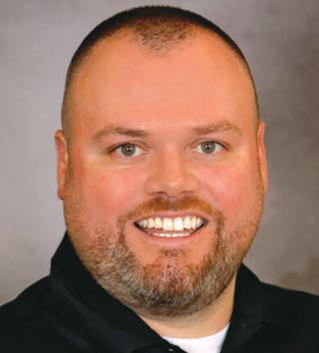
17 minute read
PROMOTIONS, NEW HIRE FUEL ECA’S GROWTH IN UNITED STATES, CANADA
Sarah Marshman has been promoted to parts and service manager at ECA Boston. Chris Horne has accepted the position of service manager of ECA Canada Company. Sam Simon has been named service manager of ECA Philadelphia.


Equipment Corporation of America (ECA) and ECA Canada Company, leading distributors of specialty foundation equipment, have announced staff changes at several branches in the United States and Canada.
Sarah Marshman has been promoted to parts and service manager at ECA Boston. After working her way through the ranks in the restaurant, medical and veterinary industries, she was recruited as office manager when the branch opened in 2015.
She earned a promotion to office manager six months later by handling a diversity of responsibilities including administrative, rental, parts and service. Marshman’s new role will require managing all aspects of ECA Boston’s parts and service while also managing office duties and reporting directly to the branch manager.
Chris Horne has accepted the position of service manager for ECA Canada Company. He has been a longtime fixture at the company, serving as shop foreman for the last five years, and service technician for 10 years. Horne supported the previous service manager by managing service technicians, fielding customer inquiries, overseeing and maintaining shop supply inventory, and assisting with loading and unloading trucks and assembling and disassembling BAUER drilling rigs with the mobile yard crane.
As service manager, Horne is now responsible for managing all aspects of the ECA Canada Service Department, including the management of technicians and satisfaction of customers.
Eric Shiring has been promoted from accounting manager to human resources manager. Stationed at ECA Pittsburgh, he will be responsible for human resources, benefits management, workers’ compensation, payroll and safety. He previously managed various aspects of ECA’s finances.
Sam Simon has been named service manager for ECA Philadelphia. A former business owner, he comes to ECA after owning an HVAC service, installation, and repair business.
He started his career as a mechanic/technician, diagnosing, repairing, and servicing mechanical equipment. Simon began with cars, trucks and buses and continued on to commercial and industrial HVAC equipment.
“These promotions are indicative of ECA’s incredible growth as we embark on our second century in business,” said ECA’s Vice President – Sales and Marketing Jeff Harmston. “The fact they are primarily promotions also reflects our identity as a family business that seeks first to promote from within.”
ECA has been a leading supplier of foundation construction equipment in the eastern United States and eastern Canada for more than a century. It is the exclusive distributor of BAUER drilling rigs, KLEMM anchor and micropile drilling rigs, RTG piling rigs and BAUER MAT slurry handling systems. It also distributes HPSI vibratory pile hammers, WORD International drill attachments, Dawson construction products, ALLU ground improvement equipment, Pile Master air hammers, DIGGA dangle drills, Olin concrete pumps and KB International synthetic polymer slurry.
ECA offers sales, rentals, service and parts from nine facilities throughout the eastern United States and eastern Canadian provinces.
For more information, visit ecanet.com.

Eric Shiring has been promoted from accounting manager to human resources manager. CISCO EQUIPMENT
www.cisco-equipment.com 1706 South 1st Street, Artesia, NM 88210 575-748-1314 Odessa, TX • 432-550-9181 Lubbock, TX • 806-745-9595 San Angelo, TX • 325-653-2121
NED - TEXAS (Formerly Four Seasons Equipment)
www.NEDealers.com Houston, TX • 800-234-5007 Dallas TX • 866-270-1700
NUECES POWER EQUIPMENT
www.nuecespower.com 7510 IH-37 Access Rd., Corpus Christi, TX 78409 361-289-0066 Laredo, TX • 956-725-0066 San Antonio, TX • 210-310-0066 San Benito, TX • 956-361-0066 Victoria, TX • 361-576-0066 El Paso, TX • 915-541-0066
PORTER GROUP USA
www.portergroupusa.com 13013 Temescal Canyon Rd, Corona, CA 92883 951-674-9999 Pacoima, CA • 818-834-0102 Newark, CA • 510-713-7368
MECOM EQUIPMENT
www.mecomequipment.com 4546 N Wilson Way, Stockton, CA 95205 209-466-5135
JET CITY EQUIPMENT
www.jetcityequipment.com 33345 SR 20, Oak Harbor, WA • 360-675-4441 Marysville, WA • 360-651-9079 Wenatchee, WA • 509-888-8181
R & S INDUSTRIES, INC.
www.rsindinc.com 951 CR G, Clovis, NM 88101 575-769-8659
RULES from page 1
It also requires reporting “critical findings” or any structural or safety-related deficiencies that require immediate follow-up inspection or action.
The updated NBIS applies to highway bridges on all public roads, on and off federal-aid highways, including tribally and federally owned bridges. It also applies to private bridges that are connected to a public road on each end.
“Periodic and thorough inspections of our nation's bridges are necessary to maintain safe bridge operation and prevent structural and functional failures,” said FHWA. “In addition, data on the condition and operation of our nation’s bridges is necessary for bridge owners to make informed investment decisions as part of an asset management program.”
In MAP-21, Congress declared that inventorying, inspecting and improving the condition of the nation’s highway bridges is in the nation’s best interests.
“As a result of this declaration and the authority established by MAP-21 in 23 U.S.C. 144, FHWA is updating the NBIS.”
New terms in the rule provide consistency and clarity in the implementation of the regulations.
This includes renaming certain existing terms in a more descriptive way, such as fracture critical member being renamed nonredundant steel tension member (NTSM).
“The final rule requires bridge inspection organizations to maintain a registry of nationally certified bridge inspectors to align with a similar provision in the National Tunnel Inspection Standards [NTIS] in 23 CFR part 650, subpart E,” said the agency.
Training requirements for program managers and team leaders have been modified by defining a required amount of refresher training for both roles and defining training needed to be a team leader on a NSTM inspection.
The regulations prescribe the permissible inspection intervals for bridges, including options for more rigorous, riskbased intervals based on the consideration of certain factors, according to FHWA.
They also provide options for establishing inspection intervals for each inspection type.
For instance, an inspection interval tolerance of three months beyond the inspection date is included.
Extended routine inspection intervals up to 48 months, and 72 months for underwater inspections are provided for.
The establishment of more rigorous, risk-based intervals in consideration of factors for routine, underwater and NSTM inspections, that would allow some inspection intervals to be up to 72 months, also is covered.
The final rule also requires written reports to FHWA of critical findings identified during inspections and provides minimum criteria for what a critical finding is, for national consistency.
“The regulations also require that a bridge inspection organization provide information to FHWA for annual compliance reviews,” said the agency.
The updated regulations include new time frames for updating inventory data and a process for tracking the updates of inventory data.
In addition, they include a new document to identify data items for the NBI. This document, “Specifications for the National Bridge Inventory (SNBI),” replaces the “Recording and Coding Guide for the Structure Inventory and Appraisal of the Nation’s Bridges (Coding Guide).”
The final SNBI document is included in the docket.
Aging Program
In 2021, FHWA marked the 50th anniversary of its NBIS, which supports the federal program that helps protect nearly 620,000 bridges across the country.
“For a half-century, NBIS standards have been at the core of federal infrastructure safety efforts,” said Stephanie Pollack, FHWA’s acting administrator. “The data we collect under the program help keep bridges safe and identify areas where maintenance is needed before problems arise.”
The NBIS umbrella covers 618,456 bridges, up from 588,735 bridges or a 4 percent increase over the past two decades, according to the American Association of State Highway and Transportation Officials (AASHTO).
It mandates regular inspections of highway bridges to detect any potential structural problems early and verify bridge maintenance schedules.
FHWA noted that state departments of transportation inspect each and every bridge at least once every 24 months.
In addition to specialized training for bridge inspectors, the program also requires the collection of bridge condition data for inclusion in FHWA’s National Bridge Inventory, which helps transportation officials make informed decisions about funding priorities.
FHWA officially adopted the NBIS regulations in 1971 after the collapse of the Silver Bridge in West Virginia in 1967 due to a crack in the bridge’s suspension chain.
“That tragedy, which cost the lives of 46 people, brought national attention to the issue of bridge condition safety and led to a systematic effort to ensure oversight at the national level,” said AASHTO.
Good Timing
The updates come at a time when nearly 224,000 bridges across the country need repair. Some 43,600 are structurally deficient and in poor condition, according to ARTBA.
The number of bridges in need of repair represents 36 percent of all U.S. bridges, according to ARTBA’s latest bridge report, released early this year.
Some 48 percent of 619,588 bridges are in fair condition. But almost 80,000 bridges should be replaced, according to ARTBA.
“If placed end-to-end, these bridges would stretch over 6,100 miles — long enough to crisscross the country from Los Angeles to Portland, Maine, and back again,” said Alison Premo Black, the association’s chief economist.
Premo Black conducted the analysis for ARTBA.
The IIJA provides states with significant new resources to make long overdue infrastructure improvements, including bridge repairs, said ARTBA.
“The longer it takes to bridge the political divide on the FY 2022 spending bills, the longer it will take for transportation improvements to get started,” Dave Bauer, ARTBA president and CEO, said. “We urge Congress to act forthwith so that the American people can begin to realize the benefits of the historic investments in the bipartisan infrastructure law.”
Based on average repair and replacement cost data published by the FHWA and submitted by bridge owners (typically state DOTs), ARTBA estimates the cost of identified repairs for all 224,000 bridges, including the 43,578 structurally deficient, is $260 billion.
The number of structurally deficient bridges was down by 1,445 compared to 2020. At current pace, it would take 30 years to repair them all, said Premo Black.
Almost half of the 619,588 U.S. bridges — 48 percent — are rated in fair condition. “This means that the bridge shows evidence of minor deterioration or minor cracks,” said ARTBA.
The number of bridges in fair condition grew by 2,916 in 2021, reaching 297,888 structures.
At 4,504, Iowa leads the list of states with the largest number of bridges in poor condition. Pennsylvania with 3,198; Illinois, 2,405; Oklahoma, 2,296; Missouri, 2,218; New York, 1,672; Louisiana, 1,631; California, 1,493; West Virginia, 1,490 and Ohio, 1,334, follow.
States and territories with the most bridges in poor condition as a percentage of their total bridge inventory are West Virginia at 20 percent; Iowa, 19 percent; Rhode Island, 17.5 percent; South Dakota, 17.3 percent; Pennsylvania, 13.8 percent; Louisiana, 12.7 percent; Maine, 12.6 percent; Puerto Rico, 12.1 percent; North Dakota, 11.2 percent and Michigan, 11 percent.
Reliable Inspections
The rule addresses requirements set by MAP-21 offering states options in determining inspection intervals for bridges.
Each state can have the option to continue their current inspection intervals if they determine the requirement is satisfactory or choose to instate more rigorous requirements for inspectors.
This latter method would call for bridge specialists to assess potential risks to the point of failure for each individual bridge, or a cluster of bridges, to be further evaluated by experts, according to the organization Report Card for America’s Infrastructure.
“Current standards set inspection intervals at roughly 24 months apart with a maximum interval being 48 months. Bridges with higher risk considerations are inspected every 12 months.”
While the first method consists of similar regulations, it does differ by requiring more thorough criteria for establishing which bridges need 12-month intervals for inspections, said the organization.
The Federal Register notice says that the second method “involves the identification and use of an interval that is commensurate with the risk of safety of service loss in a given bridge.”
Inspectors could determine the risk factors based on what is described as an “impact and consequence matrix,” serving as a formula for assessing failure probability.
This matrix was based on research by a team of civil engineers that included Robert Connor of Purdue University and Glenn Washer of the University of Missouri.
“The results of the research will allow the intervals at which bridges are inspected to be established based on a risk-based approach,” Connor said. “It’s a compliment to see your work have a potentially major impact.”
The research followed initial work conducted for FHWA that developed risk-based inspection strategies for bridges that contain NSTM, or fracture critical members.
Connor said prior to the NBIS updates, bridge inspection standards were calendar-based, calling for on-site inspections every 24 months, regardless of the bridge’s age.
There were no explicit adjustments for age or circumstances such as environmental conditions that can wear on a bridge faster.
He said the research calls for a risk-based analysis that allows inspection efforts to focus on bridges and areas that are more likely to have problems or would have significant consequences should a problem arise. CEG
Perseverance Enables Bergmann to Expand to North American Territory
BERGMANN from page 28 hours. The new machine can be recharged using a standard domestic socket outlet, a quick charging station, or via threephase industrial power.
Toben Snow (L), East Region business manager, and Tom Hartman, vice president of sales and marketing, both of Bergmann Americas Inc.
Precision-Made Products Impress American Trio
Bergmann Maschinenbau is a family company that started 62 years ago in the Emsland region of Germany. From the district’s capital city of Meppen, the equipment maker began producing the Baufix, a 2-ton dumper, in 1962, according to O’Donnell.
“The ground conditions [in that region of Germany] were often bad in places due to a lot of peat moss, with a seam about 18- to 25-feet deep,” he said. “Bergmann had to build these low-ground pressure machines to get through it. After site dumpers, it later moved into manufacturing dump trucks and track machines.”
The story of how Bergmann expanded its operations to the North American market is one of perseverance on the part of Hartman, Roberts and O’Donnell.
“Tom and Sterling found Bergmann by looking online for a certain machine, and after they saw a truck with a track machine on it, they thought that would be a great way to go for us,” said O’Donnell. “They contacted Bergmann, but the Germans said they couldn’t do anything at the time because they were building a new manufacturing facility. Later, once that plant was up and running, we contacted them again, and they said they were then ready to meet the needs of the U.S. market. Shortly after that, we put together a deal as their North American distributor.”
One of the virtues about Bergmann Maschinenbau that fueled the Americans’ excitement about becoming involved with the manufacturer was the level of artisanship and detail the German company put into its products.
Bergmann Americas Inc. and Bergmann Maschinenbau each believe in offering the best in product support. As vice president in charge of that aspect of the Bergmann Americas, Roberts has assembled a tremendous team to support the machines in the North American market with first-rate service and parts availability.
To illustrate that, O’Donnell said Bergmann’s trucks are powder-coated, and their hoses are individually wrapped.
“We have had people come by when we were at ConExpo-Con/AGG telling us, ‘You can’t do that. It adds to much expense to the machine.’ We feel, though, it adds quality to the machine, and that is well noted when people are looking at them,” he countered. “The fit and finish is fantastic, but more importantly, I think that it is part of the professionalism and the communications we have directly with the German factory. We are on the phone with them twice a week — once on Tuesdays for service meetings, and on Thursdays we talk with production and upper management.”
O’Donnell added that when Bergmann Americas finds issues with machines that it feels would make sense to modify, the German maker is always willing to listen and make the needed changes.
A good example of that productive back-and-forth across the Atlantic Ocean came when Hans-Hermann Bergmann, president of Bergmann Maschinenbau, approached Roberts at ConExpo to ask him if he had any dislikes about the current crop of its site dumpers.
“Sterling pointed to some Allen key screws that are above the battery box on the track machine and said, ‘These screws have got to go. Material is going to get overloaded from the back, getting them filled with dirt and sand, and we will have to drill that out. Just take the hex heads and put them right there,”‘ O’Donnell remembered. “Mr. Bergmann immediately picked up the phone, called the factory, and that change was made for all units coming to the U.S.
“Little things like that add up, to our way of thinking, and have contributed to the respect we have for Bergmann,” O’Donnell added. “We fully understand that if they are going to do the little things right, the big things will be done right as well.”
For more information, visit bergmannamericas.com. CEG
OKLAHOMA TERRITORY CONSTRUCTION EQUIPMENT


www.oklahomaterritoryequipment.com Oklahoma City, OK 405-917-9191 Tulsa, OK 918-835-7200
Garton Tractor Inc.
www.gartontractor.com 2400 N Golden State Blvd. • Turlock, CA 95382 209-632-3931 Fairfield, CA • 707-425-9545 Merced, CA • 209-726-4600 Modesto, CA 95356 • 209-538-0911 Newman, CA • 209-862-3760 Santa Rosa, CA • 707-586-1790 Stockton, CA 95206 • 209-948-5401 Tulare, CA 93274 • 559-686-0054 Ukiah, CA 95482 • 707-468-5880
CLM EQUIPMENT CO. INC.
www.clmequipment.com Lafayette, LA 337-837-6693 Lake Charles, LA 337-625-5942 Houston, TX 281-598-2500
BANE MACHINERY INC.
www.banemachinery.com Dallas, TX 800-594-2263 Ft. Worth, TX 800-601-2263 Tyler, TX 800-594-2200
COLUMBIA WESTERN MACHINERY
Columbiawesternmachinery.com 11125 SW Tonquin Road Sherwood, OR 97140 503-454-0902














Cooper Equipment Co.
www.cooperequip.com 201 Commerce Blvd. Georgetown, TX 78626 512-930-5151
APCO EQUIPMENT TRI-WEST TRACTOR, INC.
www.tri-westtractor.com 6281 Southfront Road Livermore, CA 94551 925-455-8200
Westrax Machinery
www.westraxmachinery.net 19618 S. Susana Rd. Rancho Dominguez, CA 90221 800-411-4717
19885 Temescal Canyon Rd Corona, CA 92881 800-411-4717
Shafer Equipment Company, Inc.
www.shaferequipmentco.com 955 Greg Street • Sparks, NV 89431 775-235-4069
Rasmussen Equipment Co.



TOUGH TASKS SEEM SMALL FROM HERE.



The G-Series Skid Steers and Compact Track Loader are majorly tough customers, because tough customers like you helped design them. With your input, we were able to push the limits of durability, engine power, and fuel capacity in all the ways our customers need. And with fewer grease zerks and extended oil-change intervals compared to earlier models, servicing is even simpler than before. Available in three models, including a radial-lift machine, the G-Series can take down the biggest jobs — and your operating costs — all at the same time. To learn more, call or visit us today.



HONNEN EQUIPMENT CO.
www.honnen.com
Denver, CO
303-287-7506 800-646-6636
Durango, CO
970-247-4460
Grand Junction, CO
970-243-7090
Ogden, UT
801-627-0049
Salt Lake City, UT
801-262-7441
St. George, UT
435-652-8003
Casper, WY
307-266-4474
Cheyenne, WY
307-316-9800
Gillette, WY 307-685-4288 Rock Springs, WY 307-382-5284 Idaho Falls, ID 208-523-9915
DOGGETT HEAVY MACHINERY SERVICES
www.doggett.com
9111 North Freeway Houston, TX 77037 713-679-6700 Beaumont, TX 409-842-1754 Bryan, TX 979-823-1905 Corpus Christi, TX 361-289-0727
San Juan, TX
956-787-0001
Victoria, TX
361-570-6666
Alexandria, LA
318-442-0455
Baton Rouge, LA
225-291-3750
Broussard, LA
337-837-9481
Covington, LA
985-893-3005
Longview, TX
903-758-3326
Lufkin, TX
936-634-8801
Monroe, LA 318-343-8787 Shreveport, LA 318-631-3090 St. Rose, LA 504-466-5577 Tyler, TX 903-592-8900








